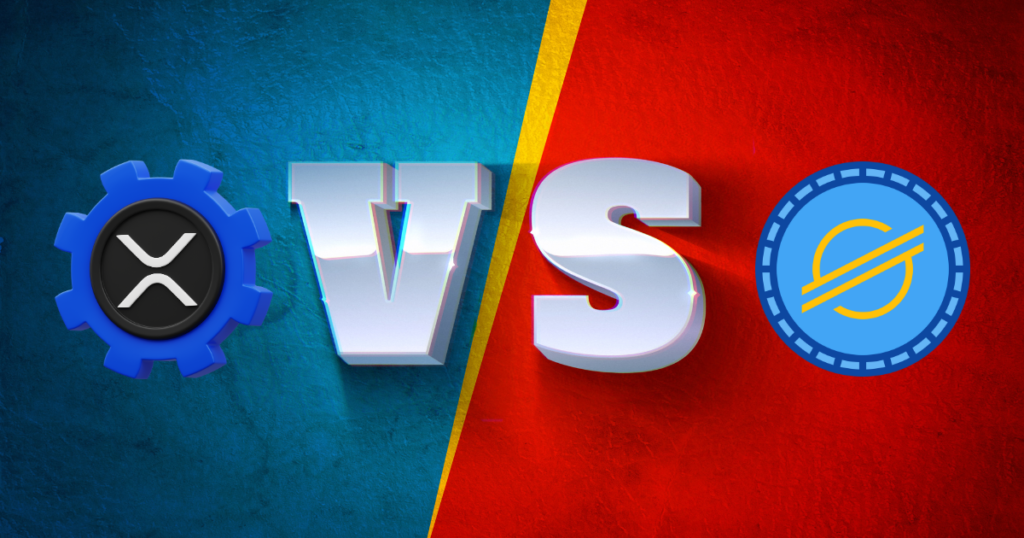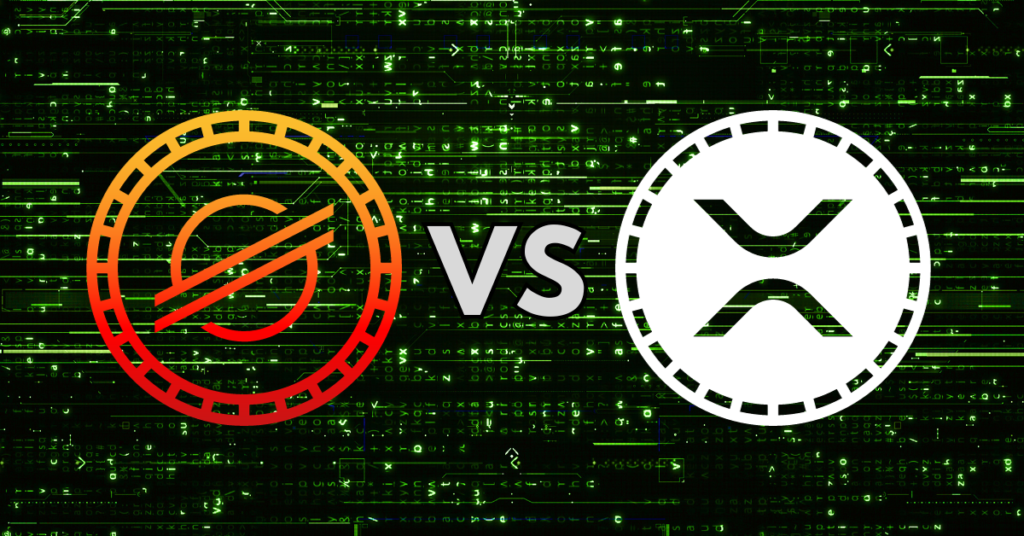Exploring the Distinctions Between Stellar (XLM) and Ripple (XRP): A Comprehensive Analysis
Cryptocurrency has evolved into a global phenomenon, with numerous digital assets serving different purposes and operating on various blockchain networks. Two such cryptocurrencies that have garnered significant attention are Stellar (XLM) and Ripple (XRP). XLM vs XRP: What are the differences between these two cryptocurrencies? Despite their shared objective of improving cross-border transactions, these two digital currencies differ in multiple aspects, including their technology, infrastructure, and regulatory challenges. In this comprehensive analysis, we will delve into the details of XLM and XRP, highlighting their differences and potential future prospects.

Understanding Stellar (XLM) and Ripple (XRP)
Stellar (XLM): Stellar, introduced in 2014 by Jed McCaleb, one of the co-founders of Ripple, is an open-source, decentralized blockchain platform. The primary aim of Stellar is to enable fast, affordable, and secure international transactions. To achieve this goal, Stellar employs its native cryptocurrency, Lumens (XLM). Lumens play a crucial role within the Stellar ecosystem. They serve as a means to prevent spam on the network by imposing a small fee on each transaction. Additionally, Lumens act as currency bridges, allowing users to seamlessly conduct cross-border payments by facilitating the exchange of various currencies.
Ripple (XRP): XRP, on the other hand, is a digital currency created by Ripple Labs and is renowned for its role in the Ripple payment protocol. This payment protocol, along with XRP, focuses on promoting cross-border payments and transfers that are both rapid and cost-effective. Ripple offers RippleNet, a network that connects banks, digital asset exchanges, and payment providers, allowing them to send money globally. Similar to Stellar, XRP functions as a bridge currency, facilitating swift cross-currency transactions. However, Ripple has faced significant challenges related to its development, adoption, and value due to legal and technological limitations.

Technology and Infrastructure
Consensus Mechanism
XLM vs XRP: Stellar employs the Stellar Consensus Protocol (SCP) as its consensus algorithm. SCP utilizes Federated Byzantine Agreements (FBA) to verify transactions, confirm their legitimacy, and ensure scalability. One of the notable advantages of SCP is its low energy consumption, which stands in stark contrast to energy-intensive mechanisms such as proof-of-work (PoW) and proof-of-stake (PoS). Stellar’s consensus mechanism enables quick and cost-efficient transactions while upholding the integrity and reliability of the network.
In the Ripple camp, the consensus mechanism of choice is the Ripple Consensus Algorithm (RCA). This mechanism is distinct from the consensus mechanisms employed by many other cryptocurrencies, such as PoW and PoS. RCA relies on a distributed agreement protocol to reach consensus on transaction order and validity. This approach results in faster transaction confirmations and lower costs when compared to traditional international transactions. Both Stellar and Ripple have chosen consensus mechanisms that prioritize efficiency and scalability.
Centralization vs. Decentralization
One of the key distinctions between XLM vs XRP lies in the level of decentralization they have achieved. While both cryptocurrencies share a common goal of enhancing the global financial industry, concerns have been raised regarding their respective degrees of centralization.
Stellar’s governance is overseen by the Stellar Development Foundation (SDF). This foundation plays a pivotal role in leading the development protocol, forming partnerships, and funding projects that contribute to the XLM ecosystem. Initially, Stellar’s network had a notable degree of centralized authority. However, over time, the platform has actively worked towards decentralization. This process allows more entities to run validator nodes, which are instrumental in validating and confirming transactions. By enabling every account to vote for the nodes they trust to validate transactions, Stellar’s network achieves increased decentralization and reduced central control.
In the case of Ripple, the network’s maintenance and verification of transactions are overseen by a specific set of validators. In the past, the network selected a group of trusted validators for administrative purposes, which raised concerns about centralization. However, Ripple has been taking progressive steps to increase the number of validators by including a more diverse range of entities in the validation process. This approach is aimed at addressing concerns about centralization and enhancing network integrity. Furthermore, Ripple’s large holdings of XRP give rise to concerns regarding centralization, as the organization wields significant control over the cryptocurrency’s supply.

Regulatory Overview
XLM vs XRP: Both Stellar and Ripple face regulatory challenges due to their involvement in financial operations, particularly cross-border transactions. The world of cryptocurrencies is not without regulatory requirements, and both XLM and XRP have implemented strategies to navigate this complex terrain.
XRP has notably faced regulatory scrutiny from the United States Securities and Exchange Commission (SEC) to determine its securities registration status. Both Stellar and Ripple have managed to navigate these regulatory hurdles through various strategies. The decentralization structure and open-source nature of these projects have played a vital role in mitigating regulatory concerns. By adhering to precise use cases, they have demonstrated their commitment to complying with evolving regulations.
Market Performance and Future Prospects
The performance of a cryptocurrency in the market is subject to various factors, including legal issues, regulatory actions, market sentiments, and partnerships with financial institutions. Both XLM and XRP have experienced market fluctuations and volatility over time, influencing market trends within the blockchain space.
For example, Ripple’s legal issues had a significant impact on its market value and overall trading volumes. Market volatility is a major influencer of shifts in the cryptocurrency market. Various indicators of market performance, such as market sentiments and regulatory actions, have had an impact on the prices of XLM and XRP. The future growth and development of these two cryptocurrencies depend on their ability to adapt to changes in regulations and shifts in market demands.

Key Differences XLM vs XRP
- Decentralization: Stellar is actively working towards decentralization, allowing more entities to participate in network validation and reducing central control. In contrast, Ripple is also moving in this direction but faces concerns due to its substantial holdings of XRP.
- Use Cases: Stellar focuses on forming partnerships, promoting inclusivity, and expanding its utility beyond cross-border transactions. Ripple, on the other hand, primarily targets financial institutions, making it unique in the cryptocurrency industry.
- Regulatory Challenges: Both cryptocurrencies have faced regulatory scrutiny, but their strategies, such as decentralization and adherence to specific use cases, have helped them navigate these challenges.
- Future Prospects: Stellar’s future prospects are linked to its commitment to technological advancements and financial inclusion. For Ripple, resolving legal disputes that affect its classification could play a pivotal role in its future growth.
In conclusion, while Stellar (XLM) and Ripple (XRP) share a common goal of revolutionizing cross-border transactions to make them faster, more accessible, and cost-effective, they exhibit significant differences in terms of technology, partnerships, target audience, and how they address regulatory challenges. Their success will depend on their utility, adaptability, ability to address centralization concerns, and their capacity to remain compliant with evolving regulatory requirements. These two cryptocurrencies represent distinct approaches in the blockchain world, offering unique solutions to the challenges of cross-border transactions.









